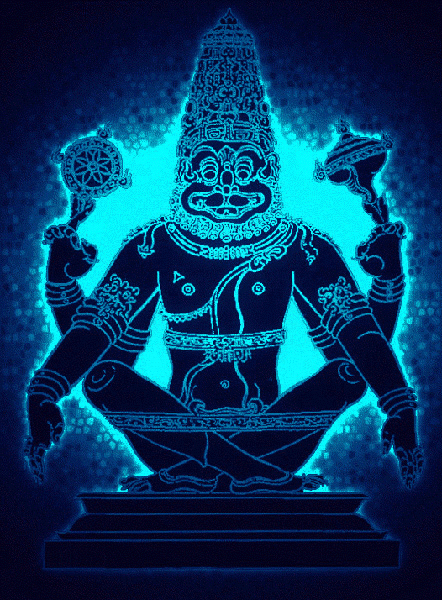
Lord Nrsimha holding the Conch and Disc
Lord Vishnu descends in the forms of a variety of avatars, all of whom are non-different from Him. All the avatars are of the nature of sat-cid-ananda: eternity, bliss and knowledge. They reside in the spiritual world, Vaikuntha. When They descend into the material world, They are called “avatara” (literally, “descent”). Any attempt to minimize the transcendental status of any avatar constitutes an offense and is a stumbling block on the path of self-realization. And to understand Lord Nrsimha, one must first appreciate the transcendence of Vishnu.
Lord Vishnu descends in the forms of a variety of avatars, all of whom are non-different from Him. All the avatars are of the nature of sat-cid-ananda: eternity, bliss and knowledge. They reside in the spiritual world, Vaikuntha. When They descend into the material world, They are called “avatara” (literally, “descent”). Any attempt to minimize the transcendental status of any avatar constitutes an offense and is a stumbling block on the path of self-realization. And to understand Lord Nrsimha, one must first appreciate the transcendence of Vishnu.
The scriptures describe Lord Nrsimha as prominently manifesting all six attributes of God – strength, wealth, renunciation, splendor, energy, wisdom. “In Nrsimha, Rama, and Krishna, all the six opulences are fully manifest.” (nrsimha-rama-krsnesu sad-gunyam paripuritam–Padma-purana).
Lord Krishna or Lord Narayana is considered to be the origin of the other transcendental forms of God. From Narayana, Vasudeva is manifest, and from Vasudeva, Sankarsana is manifest (Agni-purana 48.13). And according to the scriptures, Lord Nrsimha is an expansion (amsha) of Sankarsana. [Padma-tantra 1.2.31 and Vishnu-dharmottara-purana 3.78(2).5-7 (haris Sankarsanamsena Nrsimha-vapur dharah)] Just as Sankarsana destroys the universe, Lord Nrsimha destroys all ignorance and all sins arising from body, mind and speech.
Lord Narsimha Himself is recognized in the scriptures by a variety of forms. The Vihagendra-samhita (4.17) of the Pancaratra-Agama enumerate more than seventy forms of Nrsimha. Most of these forms are distinguished by the arrangements of weapons in the hands, His different postures, or other subtle distinctions.
Of these seventy-four, nine are very prominent (Nava-vyuha-nrsimha):
Ugra-nrsimha Kruddha-nrsimha
Kruddha-nrsimha Vira-nrsimha
Vira-nrsimha
Vilamba-nrsimha Kopa-nrsimha
Kopa-nrsimha Yoga-nrsimha
Yoga-nrsimha
Aghora-nrsimha Sudarsana-nrsimha
Sudarsana-nrsimha Laksmi-nrsimha
Laksmi-nrsimha
Other forms are as follows:
Amrta-nrsimha (representing the five elements)
Astamo-diina-vallabhah (Beloved to the wretched)
Attahasa-nrsimha (roars horribly and majestically strides out to destroy evil)
Avesha-nrsimha (a frenzied form)
Brahma-nrsimha, Vishnu-nrsimha, and Rudra-nrsimha
Chanda-nrsimha (ferocious)
Chhatra-nrsimha (seated under a parasol of the five-hooded serpent)
Chakra-nrsimha (with only a discus in hand)
Caturthaastu-vidhaaranah (One who rips apart)
Dashamo-‘nanta hastakah (One who has unlimited hands)
Dvaadashah-karuna nidhih (Ocean of Mercy)
Dvitiiyas-tugrakesharih (Angry Lion)
Ekaadasho-mahaa-raudro (Terrible One)
Ghora-nrsimha (ferocious)
Grahana-nrsimha (catching hold of the demon)
Jvala-nrsimha (with a flame-like mane)
Laksmi-nrsimha (where Laksmi pacifies Him)
Navamo-prahlaada-varado (Benefactor of Prahlada)
Pan-casya-pan-camashcaiva (One who has five mouths)
Prasada-nrsimha or Prahlada-varada-nrsimha (Benign Protector of Prahlada)
Pratamaastu-mahaajvaalo (Greatly fiery one)
Prthvi-nrsimha, Vayu-nrsimha, Akasa-nrsimha, Jvalana-nrsimha and Pusthi nrsimha (worshipped for overcoming evil influences)
Samhara-nrsimha (killing the demon)
Saptamo-daitya hantaa ca (The Killer of the demons)
Shasta-kashipu mardhanah (Killer of Hiranyakashipu)
Stambha-nrsimha (coming out of the pillar)
Svayam-nrsimha (manifesting on His own)
Tritiiyah-krsna pingaaksah (One with Blackish Brown Eyes)
Vidarana-nrsimha (ripping open of the belly of the demon)
Yoga-nrsimha or Yogesvara-nrsimha (in meditation)
There are still other varieties that are standing, riding on Garuda, alone, in company, benign, ferocious, and multi-armed (two to sixteen). All of these forms point to the diversity in transcendence of the Nrsimha-Avatar.
In Ahobila, Andhra Pradesh, the ten forms are as follows:
Kshatra-vata-nrsimha (seated under a banyan tree)
Yogananda-nrsimha (who blessed Lord Brahma)
Karanja-nrsimha
Bhargava-nrsimha
Ugra-nrsimha (ferocious)
Kroda-nrsimha
Malola-nrsimha (with Laksmi on His lap)
Jvala-nrsimha (8-armed form rushing out of the pillar)
Pavana-nrsimha (who blessed the sage Bharadvaja)
Prahlada-padi nrsimha
Leave a Reply